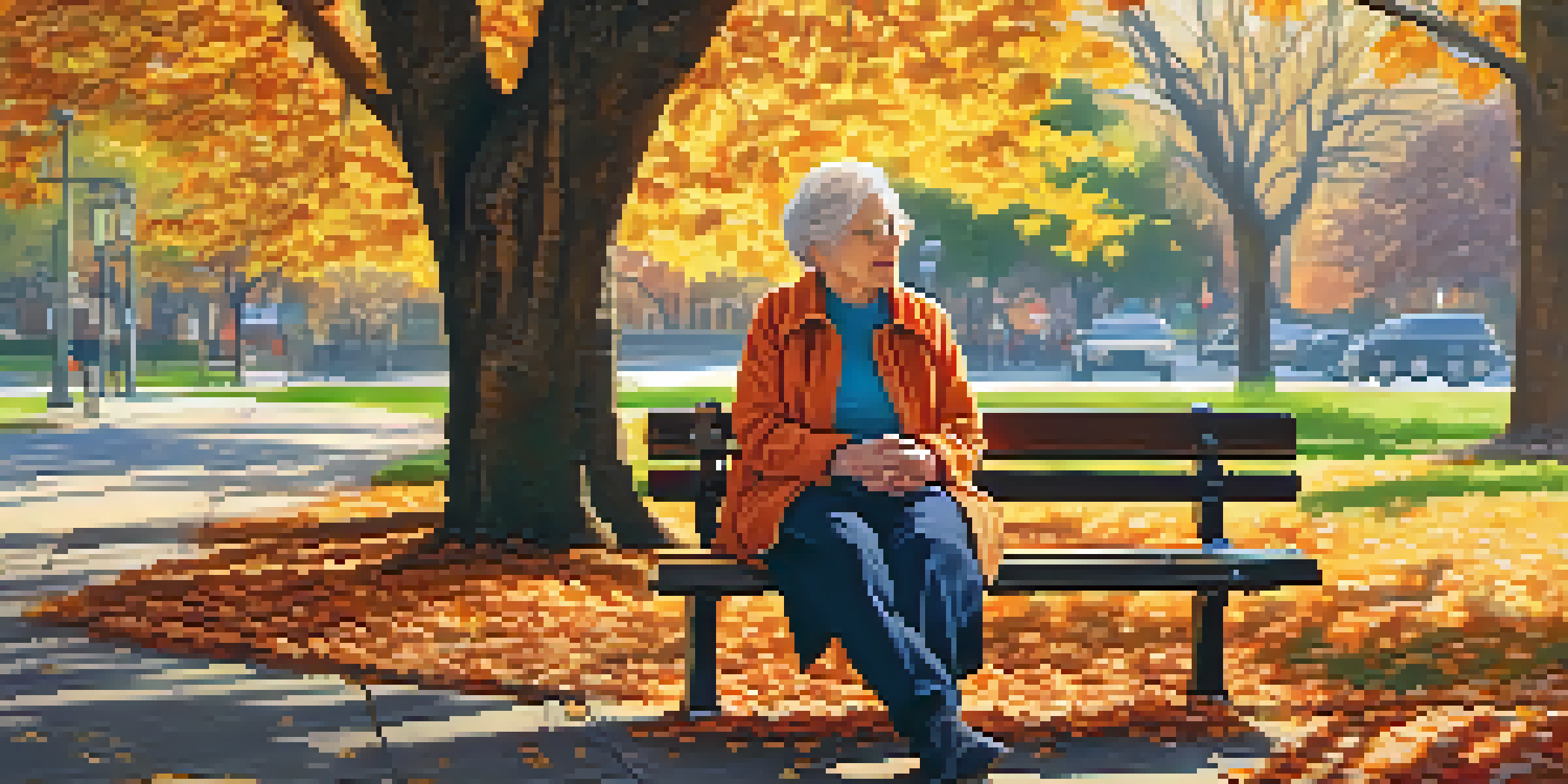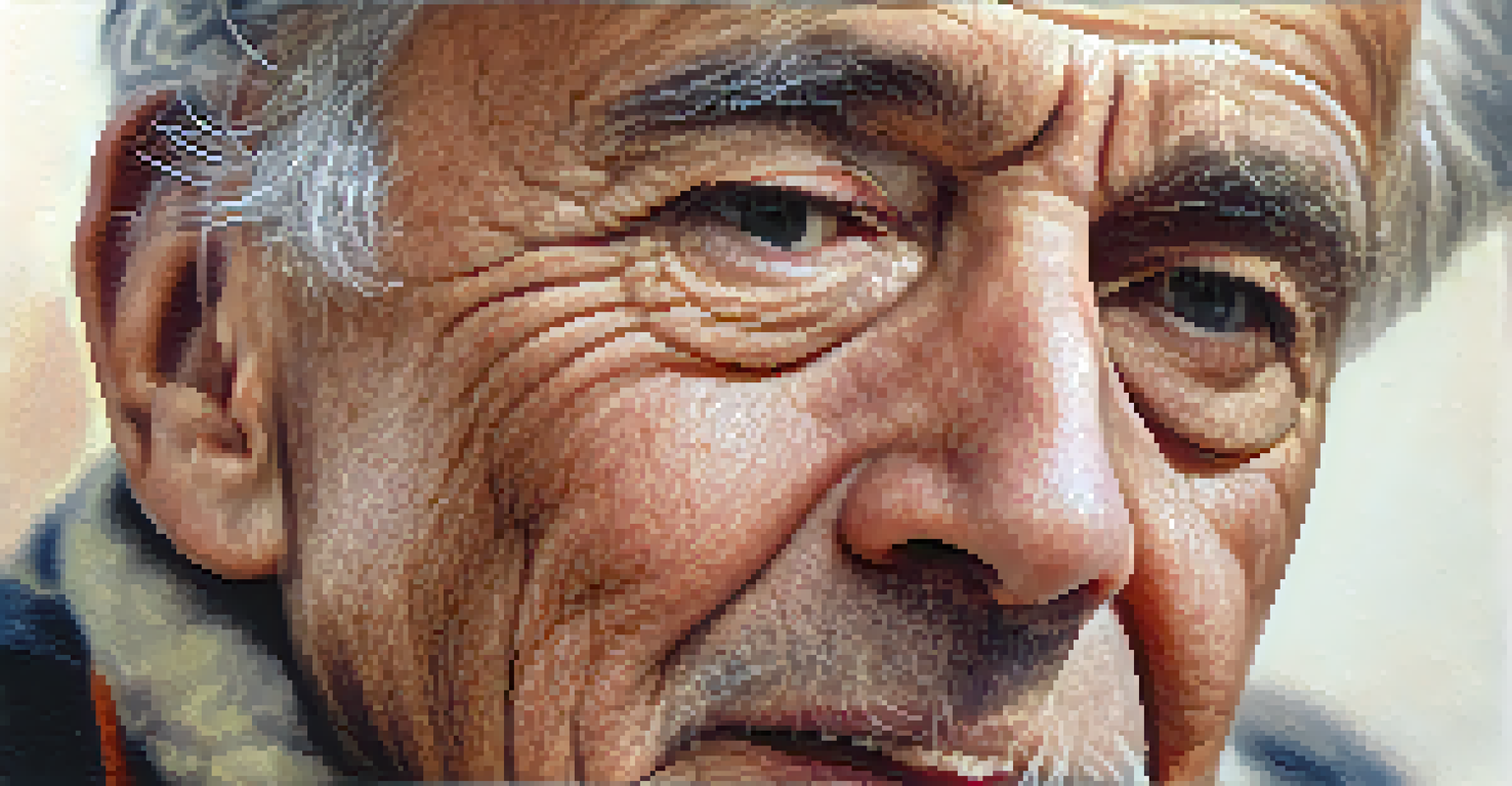Narratives of Aging: Storytelling in Visual Arts

Understanding Aging Narratives in Visual Arts
Aging is a universal experience, yet it often remains shrouded in stereotypes and misconceptions. Visual arts provide a unique platform to explore and express the complexities of aging. Through paintings, photography, and sculpture, artists can narrate the rich stories that come with age, presenting a more nuanced understanding of this life stage.
Aging is an extraordinary process where you become the person you always should have been.
By capturing the diverse experiences of aging, artists challenge societal norms and provide a voice to the often overlooked narratives of older adults. This storytelling can evoke empathy, provoke thought, and foster connection between generations. In essence, visual arts become a medium for conversation about aging, bridging the gap between youth and the elderly.
For instance, consider the poignant photographs of elderly individuals that reveal their life stories through the lines on their faces and the sparkle in their eyes. These images not only document aging but also celebrate the wisdom and resilience that often accompanies it.
The Role of Artists in Shaping Aging Narratives
Artists play a crucial role in shaping how society perceives aging. By choosing to depict older individuals in their work, they can redefine beauty and vitality beyond traditional standards. This artistic choice not only empowers older adults but also invites viewers to reconsider their own perceptions of aging.

Many artists draw inspiration from their personal experiences with aging, whether through family members or their own journeys. This personal connection infuses their work with authenticity and emotional depth. For example, an artist might create a series of portraits of their grandparents, highlighting their stories and struggles, thus preserving their legacy.
Art Redefines Aging Narratives
Visual arts challenge stereotypes about aging by showcasing the rich stories and resilience of older adults.
Moreover, artists often collaborate with older community members, bringing their stories to life in a way that honors their experiences. This collaboration ensures that the narratives presented are not only accurate but also resonate deeply with those who have lived them.
Visual Arts as a Tool for Social Change
Visual arts can serve as a powerful tool for social change, particularly in the realm of aging. By showcasing the realities of older adults, artists challenge ageism and promote inclusivity. Their work can spark conversations that lead to greater awareness and advocacy for the rights and needs of the elderly.
The longer I live, the more I realize the impact of attitude on life. Attitude, to me, is more important than facts.
For instance, community art projects that involve older adults can help reduce stereotypes by highlighting their contributions to society. These projects often result in powerful visual narratives that depict aging as a vibrant and significant part of life. Through these representations, society can begin to see aging not as a decline but as a continuation of an individual's story.
Additionally, exhibitions focused on aging can attract diverse audiences, fostering intergenerational dialogue. When younger viewers engage with art that addresses aging, they may be more inclined to reflect on their own futures and the value of intergenerational relationships.
The Emotional Impact of Aging Narratives
Art has a profound ability to evoke emotions, and narratives of aging are no exception. When artists portray the struggles, joys, and complexities of growing older, they tap into universal feelings of nostalgia, loss, and resilience. This emotional connection can be both healing and enlightening for viewers.
For example, a painting that depicts a solitary elderly figure gazing out at a sunset may evoke feelings of loneliness, but it can also inspire reflection on the beauty of life's transitions. Such imagery allows viewers to confront their own emotions regarding aging and mortality in a safe and contemplative space.
Artists Foster Intergenerational Dialogue
Through collaboration with older individuals, artists create authentic narratives that bridge the gap between generations.
Furthermore, these emotional narratives can foster a sense of community through shared experiences. When individuals relate to the stories told through visual arts, they often feel less isolated in their experiences of aging, leading to deeper connections with one another.
Cultural Perspectives on Aging in Visual Arts
Cultural backgrounds significantly influence how aging is portrayed in visual arts. Different cultures have varying perceptions of aging, which are often reflected in their artistic expressions. For instance, some cultures celebrate aging as a sign of wisdom and experience, while others may view it through a lens of decline.
Artists from diverse backgrounds bring their unique perspectives to the forefront, enriching the narratives of aging. This cultural variety allows for a more comprehensive understanding of what aging means across different societies. For example, Indigenous artists may highlight the importance of elders as custodians of knowledge and tradition, contrasting sharply with more Western perspectives.
As global interconnectedness grows, so too does the opportunity for cross-cultural dialogue through visual arts. This exchange not only broadens the narrative of aging but also promotes appreciation for the diverse experiences that come with it.
The Future of Aging Narratives in Visual Arts
As society evolves, so too will the narratives surrounding aging in visual arts. With advancements in technology and media, artists now have more tools than ever to explore and portray the aging experience. Digital art, virtual reality, and interactive installations are just a few examples of how these narratives can be transformed.
These new mediums offer fresh perspectives and can engage younger audiences in discussions about aging. For instance, virtual reality experiences can allow users to 'walk in the shoes' of an older person, fostering empathy and understanding. This innovative approach can reshape perceptions and encourage a more compassionate view of aging.
Cultural Perspectives Shape Aging Views
Diverse cultural backgrounds influence artistic expressions of aging, enriching the understanding of this universal experience.
Moreover, as the population ages, the demand for authentic representations of older adults will likely increase. Artists will continue to play a vital role in capturing these evolving narratives, ensuring that the stories of aging are told with dignity and respect.
Conclusion: The Power of Visual Storytelling in Aging
In conclusion, narratives of aging told through visual arts hold immense power. They challenge societal norms, foster empathy, and promote understanding of the complexities of growing older. By engaging with these narratives, we are not only honoring the stories of older adults but also enriching our own perspectives on aging.
As we move forward, it is essential to support artists who are committed to depicting the diverse experiences of aging. Their work can catalyze important conversations and inspire action towards a more inclusive society. By embracing these stories, we can dismantle ageism and celebrate the beauty of every life stage.

Ultimately, visual storytelling serves as a reminder that aging is not merely about decline but about living fully, with all its joys and challenges. Through the lens of art, we can appreciate the richness of life at every age, embracing the narratives that shape our understanding of the human experience.